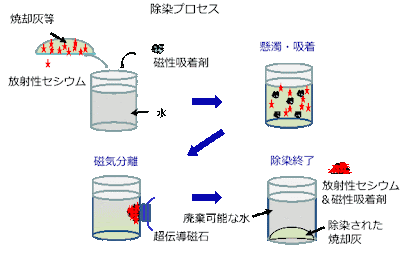New Radioactive Cesium Absorbents
Since the occurrence of the Fukushima Daiichi nuclear accident, Japanese scientists have been fighting the radiation disaster in their own ways.
One of results of their efforts is new material to absorb radioactive cesium more efficiently than conventional absorbent material such as zeolite and Prussian blue.
The National Institute for Materials Science of Japan developed new material made of silica which has an uncountable number of small dents and holes on its surface. These pores have each the diameter of several nano-meters (several billionths of 1 meter ). It can take only cesium. Its performance of absorbing radioactive cesium elements is 100 times stronger than a conventional method such as zeolite.
The effect of AIST's absorbent is demonstrated in the above figure. The vertical axis is for the absorption rate; the horizontal axis for the liquid-solid ratio (concentration). Red and blue lines are for nano particles; green for PB sold in the market; and black for zeolite.
Other team of scientists have also developed a new type of absorbent material for radioactive cesium. Scientists of Shinsyu University and Hokkaido University of Japan have invented a new method of taking away radioactive cesium using carbon-nano tube (CNT) material. This material can absorb cesium 100 times more than Prussian blue (PB). Specifically, they combine CNT and PB to put them into foamable resin. When they pour radioactively contaminated water to this resin, it could remove 97% of radioactive cesium.
Mitsubishi Paper Mills has also completed development of magnetic absorbent of cesium called CS-Catch. It is comprised of inorganic adsorbent and magnetic powder. As inorganic absorbent, they adopt ferric ferrocyanide and zeolite. Specifically, this product is put in water with burned ash of radioactively contaminated woods, weeds, concrete, and other substance. Then radioactive cesium melted into water can be collected by the magnetic absorbent.
There some other scientists and businesses in Japan which are engaged in development of new types of absorbent for radioactive elements which are discharged in a radioactive or nuclear accident.
Some of these products are now being field-tested in the Fukushima Daiichi Plant. Though the market of these types of material is limited, countries operating nuclear power plants should obtain them as measures to prepare emergency.
APPENDIX: How Prussian Blue Works in Absorbing Cesium



